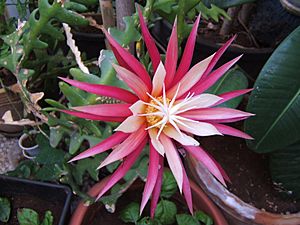Fish bone cactus facts for kids
Quick facts for kids Fish bone cactus |
|
|---|---|
 |
|
| The flower of Selenicereus anthonyanus | |
| Conservation status | |
| Scientific classification | |
| Genus: |
Selenicereus
|
| Species: |
anthonyanus
|
| Synonyms | |
|
|
The Fishbone Cactus (its scientific name is Selenicereus anthonyanus) is a cool type of cactus. It comes from southern Mexico. People love to grow it because it has amazing flowers that open at night! Its stems also look really unique, like leaves with zig-zag edges. That's why it's also called the rickrack cactus or zig-zag cactus. Some even call it an orchid cactus because of its beautiful blooms.
Contents
What the Fishbone Cactus Looks Like
The stems of the Fishbone Cactus can grow upwards or climb like a vine. They can be over 1 meter (about 3 feet) long and are flat, about 7 to 15 centimeters (3 to 6 inches) wide. These stems have cool, deep zig-zag edges, which is how the plant gets its common name.
The plant's flowers are very special. They are super fragrant and can be 10 to 12 centimeters (4 to 5 inches) long and 15 to 17 centimeters (6 to 7 inches) wide. The outer petals are purple, while the inner ones are creamy yellow near the center.
After the flowers, the plant grows round or oval fruits up to 6 centimeters (2.4 inches) big. These fruits have small, prickly spots that fall off as they get older. Inside, you'll find tiny black seeds.
Where It Lives
The Fishbone Cactus naturally grows in the warm, wet rainforests of southern Mexico. You can find it in states like Chiapas, Oaxaca, Tabasco, and Veracruz. It usually grows at heights of about 180 to 500 meters (about 590 to 1,640 feet) above sea level.
How It Got Its Name
This cactus is named after Harold E. Anthony, who was the first person to get this plant to flower in June 1950. Before that, it was known by an older name, Cryptocereus, which means "hidden cereus." This name came about because the plant stayed hidden for a long time, even though people had explored the area where it grew.
A scientist named Thomas MacDougall found this plant in 1946. He thought it was similar to another cactus called Epiphyllum anguliger. But when it finally bloomed in Dr. Harold E. Anthony's greenhouses in Jersey in 1950, everyone realized it was a brand new and exciting discovery! Most of the Fishbone Cacti grown today come from that very first plant found by MacDougall.
How to Grow It
The Fishbone Cactus is quite easy to grow and grows quickly. It's an epiphyte, which means it naturally grows on other plants (like trees) in its habitat, but it doesn't harm them.
When you grow it, make sure its soil has lots of rich plant material, like compost. It needs enough water in the summer. You can keep it in a spot with some shade or even full sun, but it doesn't like cold weather. Make sure it stays above 4°C (39°F) in winter. Giving it extra light in early spring can help it grow more flower buds.
Its amazing flowers only open for one night! They have a strong, sweet smell to attract animals that fly at night, like moths, to help them spread their pollen. The Fishbone Cactus usually blooms in late spring or early summer.
See also
 In Spanish: Selenicereus anthonyanus para niños
In Spanish: Selenicereus anthonyanus para niños





